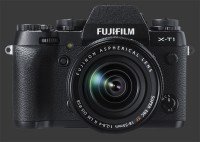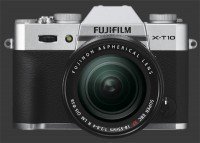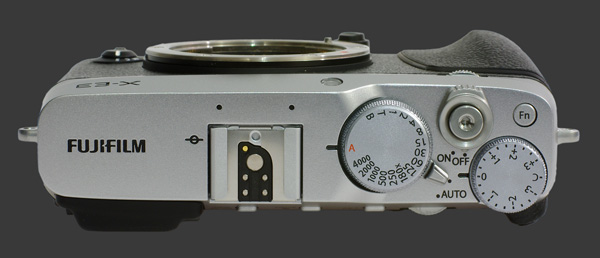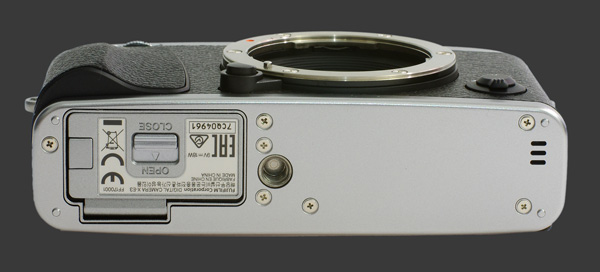Fujifilm X-E3 Review
Fujifilm X-E3 Introduction
The Fujifilm X-E3 is a streamlined member of the X-E family with the latest 24 megapixels X-Trans CMOS III sensor. This sensor seen on the X-T20
Fujifilm X-T20 features a built-in 325-Point Phase-Detect AF system. As with all X-family mirrorless, this APS-C sensor has a 1.5X crop-factor and 3:2 aspect-ratio except that it forgoes an Anti-Alias Filter thanks to its unique color-filter which is not prone to moire.
The original Fujifilm mirrorless, the X-Pro1
Fujifilm X-Pro1 was quickly followed by a smaller X-E1
Fujifilm X-E1 with a similarly-styled rangefinder body. The latter was succeeded by an X-E2
Fujifilm X-E2 and then an X-E2S
Fujifilm X-E2s, all with nearly identical bodies. When the flagship X-T1
Fujifilm X-T1 was launched an miniaturized as an X-T10
Fujifilm X-T10, both eventually replaced by the X-T2
Fujifilm X-T2 and X-T20
Fujifilm X-T20, the rangefinder design started looking overly large for something that really should not be. The X-E3 is a bold and unique answer to this situation.
Although significantly smaller than its predecessor, the Fujifilm X-E3 packs a full feature-set and a good number of controls, including dual control-dials, a shutter-speed dial and an EC dial. For the first in a mirrorless, the X-E3 dispenses of the 4-way controller in favor of a much smaller 8-way joystick. This allows the back of the camera to be compacted while keeping a large 1 megapixel 3" LCD and reasonably-sized 2.4 megapixels 0.39" EVF with built-in Eye-Start sensor. As with all cameras of this class, the X-E3 offers full manual controls, including choice of metering, extensive white-balance options and a number of bracketing modes.
The 24 megapixels sensor in the Fujifilm X-E3 offers a standard ISO 200-12800 sensitivity range, expandable to ISO 100-51200, and up to 400% Dynamic-Range at middle sensitivities. There is a hybrid shutter in the X-E3 that covers shutter-speeds of 1/32000 to 30s, plus allows for Bulb exposures of up to an hour. The fast X-Processor Pro in the X-E3 can process 14 frames per second which is possible when the electronic shutter is used. In mechanical mode, the X-E3 can still capture a respectable 8 FPS.
This digital camera review analyses the usability, performance and image quality of the Fujifilm X-E3. Given the drastic change in physical interface, this is definitely a review to read thoroughly as no other camera operates this way.

Fuji X-E3 Features
Sensor
- 24 Megapixels X-Trans CMOS III sensor
- X-Trans 6x6 Color-Filter Array
- No Anti-Alias filter
- 3:2 Aspect ratio
- 1.5X Crop factor (APS-C)
- 325-Point Phase-Detect AF
- Fuji XF lens mount
- Dust-Reduction
Exposure
- ISO 200 to 12800 sensitivity range, 1/3 EV steps
- ISO 100, 25600 and 51200 expansion
- Auto ISO, Maximum from 400 to 12800
- ISO Bracketing, 3 frames, 1/3-1 EV steps
- 1/32000s-60mins Shutter-Speeds, 1/3 EV steps
- 1-15mins Shutter-Speeds, 1 EV steps
- Bulb exposure, maximum 1 hour
- PASM Exposure modes, plus Bulb
- Multi-Segment, Center-Weighed, Spot and Average metering
- Exposure-Compensation, ±5, 1/3 EV increments
- AEB, 3-9 frames, 1/3-3 EV increments
- 100%, 200% or 400% Dynamic-Range
- Dynamic-Range Bracketing, 3 frames
- 1/180s Flash Sync
Image Parameters
- Automatic, 7 presetsSunny, Shade, 3 Fluorescents, Incandescent, Underwater, Kelvin and Custom WB
- WB Fine-Tuning along 2 axis in 19 steps
- WB Bracketing, 4 frames, 3 step sizes
- Film Simulation: Provia, Velvia, Astia, Classic Chrome, Pro Negative Hi, Pro Negative Standard, Across, Monochrome and Sepia
- Film Simulation Bracketing, 3 frames
- Adjustable Color & Sharpness, 9 steps each
- Adjustable Highlight & Shadow Tone, 7 steps each
- Adjustable Noise Reduction, 9 levels
- Optional Long-Shutter Noise Reduction
- Optional Lens Modulation Optimizer
Focus
- Single-Shot AF, Continuous AF or Manual Focus
- Single-Point, Area or Auto Focus Selection
- Hybrid 325-Point AF system
- Optional Eye and Face Tracking
- Optional Digital Split Image
- Optional Focus Peaking
- Optional MF-Assist
- Optional AF-Assist Lamp
Drive
- 14 FPS Electronic-Shutter Continuous Drive,
Max 35 JPEG or 22 RAW - 8 FPS Mechanical Shutter Continuous Drive,
Max 62 JPEG or 25 RAW - Self-timer, 2s or 10s
- Motion Panorama, 180° or 120°
- Interval Timer:
- 1s-24h Frame Interval
- 1-999 or Unlimited Frames
- Instant or 1m-24h Start Delay
- Multiple-Exposure, 2 frames
Display & Viewfinder
- 0.39" EVF:
- 2.4 Megapixels
- 0.62X Magnification
- 100% Coverage
- Eye-Start Sensor
- 3" Touchscreen LCD
- 1 Megapixel
- 100% Coverage
- 3:2 Aspect-Ratio
- Status Screen with Live Histogram
- Digital Level, Single-Axis
- Depth-Of-Field Preview
- Optional Live-Histogram
- Optional Framing-Guides, 3 types
Output Processing
- 16:9 and 1:1 Cropped Aspect-Ratios
- 24, 12 and 6 Megapixels modes
- JPEG, RAW, RAW+JPEG capture
- 2 JPEG Image compression levels
- Optional Lossless RAW compression
- Optional Grain Effect, 2 levels
Video
- 3840 x 2160 @ 30 FPS 4K Ultra HD Video
- 1920x1080 @ 60 FPS 1080p Full HD Video
- Quicktime, MPEG-4 Codec
- Built-in Stereo Microphone
- Stereo Audio Input Mini-Jack
- Memory Card or HDMI Output
- Optional HDMI output overlay
Controls & Body
- Dual Control-Dials
- Customizable AE-L button
- Customizable AF-L button
- Customizable Function Button
- Customizable Rear-Dial Click
- 4 Customizable Swipes
- EC Dial, ±3 EV, 1/3 steps
- Shutter-Speed Dial, 1/4000-1s, Full-Stops
- Auto Mode Switch
- Standard Hot-Shoe
- Wired remote
- Built-in WiFi
- Built-in Bluetooth
- 4K HDMI output
- USB 2.0 Connectivity
- SDXC UHS-I Memory slot
- Proprietary Lithium-Ion battery
- Internal charging via MicroUSB
- External charger supplied
Fujifilm X-E3 Usability - How easy is it to use?
Fujifilm is famous for making retro-styled digital cameras. Their latest embodiment offers a refined hybrid rangefinder design. The X-E3 has a very rectangular body with rounded corners and a slight rubberized grip. The soft rubber coating helps hold the camera yet there is not much of a grip. This, plus the viewfinder at the upper-right corner of the body, gives it the rangefinder look. A few direct dials and a metal shutter with screw-in remote connector completes its retro style. This lets the camera be used very close to the body, reducing the footprint of the photographer.

This mirrorless camera is very solid. Its top and bottom plates are made of metal as are all dials on the camera. The whole thing feels well put together and even the doors, one for the connectors and one for the battery and memory card, are quite sturdy. Eyelets to support a neck-strap on either wide of the camera blend with the top-plate. At 337g, this not a heavy camera by any means. It can be used for hours without tiring the photographer, unless a heavy lens is mounted.
The front of the X-E3 is quite bare. There is a small rubber hand-grip and a 3-position switch to control the Focus-Drive mode on the opposite side. The options are Single-Shot autofocus, Continuous autofocus and Manual focus. A small AF-Assist lamp above the lens mount is there to help focus. In practice though, it does very little since it is often obstructed by the lens.

The top of the Fuji X-E3 is distinctly retro. Only the Fn button here gives a hint of modernity. This button can be programed to activate one of a whopping 35 functions: Image Size, Image Quality, RAW, Film Simulation, Grain Effect, Dynamic-Range, White-Balance, Custom Setting, Focus Area, Focus Check, AF Mode, AF-C Custom Setting, Face/Eye Detection, Self-Timer, AEB Setting, Photometry, Shutter-Type, ISO, Wireless Communication, Flash Setting, TTL Lock, Modeling Flash, Mic Level, DOF Preview, Preview Exposure/White-Balance in Manual Mode, Preview Picture Effect, Histogram, AE-L, AF-L, AE/AF-L, AF-On, Aperture, Auto Image Transfer, Bluetooth Toggle, Playback or None. It is a tough call choosing which one to assign but there is no way to use DOF Preview or any of the Locking Features if not assigned to a function button.
There is a dedicated Exposure Compensation dial with markings ±3 EV in 1/3 stops, plus a C position. The latter allows EC to be dialed in ±5 EV in 1/3 stops using the front control-dial. Note that the front control-dial is clickable which makes it cycle between each of its functions, When the EC dial is set to C, it may need to be clicked once or twice in order to use the front control-dial to change exposure.
Next on the top plate is a small shutter-release surrounded by a rotating power-switch. It has the obvious On and Off positions. The shutter-release has an unusually long travel to the halfway point which sometimes gives the impression of unresponsiveness. It takes a little time getting used to. The shutter-release is threaded to accept a traditional screw-in wired remote shutter-release.

The largest dial on the top-plate is the Shutter-Speed dial. It is marked in full-stops with shutter-speeds from 1/4000s to 1s. Any shutter-speed above, below or in-between must be selected via the rear control-dial. To access shutter-speeds beyond one second, the dial must be rotated to the T position. To let the camera automatically select the shutter-speed, the dial must be set to the red A position. As with other Fujifilm cameras, this is a clumsy system that seems to slow things down more than anything. Ideally one would have to set the shutter-speed with the rear control-dial alone and repurpose this dial as an ISO dial which would have enough room for all sensitivities.
The X-E3 has a class-leading shutter-speed range, all accessible with the Shutter-Speed dial at the T position. With the shutter in Electronic or Hybrid mode, it can reach a top speed of 1/32000s which can freeze extremely fast action such as hummingbirds in flight. In Mechanical mode, the top speed is a standard 1/4000s. Speeds from 1/32000s to 60s are available in 1/3 stops. Beyond that, this mirrorless offers up to 15 minutes of exposure in full-stops. There is also a Bulb mode that can capture exposures of up to an hour.
At the base of the Shutter-Speed dial, there is an Auto switch. When pulled towards the back of the camera, it places the X-E3 in automatic mode. EC is still available while ISO, Aperture and Shutter-Speed are all set automatically, ignoring the aperture ring, the selected shutter-speed, the focus switch and focus post ion. In Auto mode, the front control-dial selects between one of 14 Scene Modes.
The final things to see on the top plate are a standard hot-shoe and a pair of microphones just in front of it. There is no built-in flash yet a small one is supplied with the camera. This makes the camera itself rather sturdy as there are no moving parts besides the 4 dials and buttons.
Fujifilm describes the X-E3 as built in the pursuit of minimalism. Indeed it has fewer controls than its predecessor but they are better used. The dual control-dials are key to this achievement. The rear one, in addition to selecting shutter-speed as described already in this review, is also clickable. This lets it activate a number of functions including MF Assist. The front control dial can also be clicked to cycle between up to three parameters: ISO, Aperture and EC. There is no ISO dial, so it generally is left to control ISO alone. When a lens does not have an aperture ring or has one with a C position, the front control-dial selects the aperture. Finally, as mentioned earlier, it sets EC when the Exposure-Compensation dial is set to C.

A large 3" LCD with 1 megapixel of resolution dominates the back of the camera. The screen is bright with good color, contrast and visibility. It is also a highly customizable touchscreen. Touching it can move the focus-point or focus-area and swiping towards each edge can be assigned one of the same 35 functions as the Fn button. Menus items can be activated by touch too. It is prone to accidental activation though, so luckily the touch functionality can be disabled.
Above the LCD there is a very nice 0.39" built-in EVF with Eye-Start sensor. It has a relatively large 0.62X magnification and always shows 100% coverage. With 2.4 megapixels of resolution, it is incredibly precise. It shows very little lag and maintains a moderately bright view. Under bright sunlight though, even the EVF becomes difficult to see. The one true pain-point of the X-E3 is that the preview is most often incorrect, displaying the wrong exposure or white-balance quite often. Even though there is an option to become Exposure-Priority, it is only applicable in Manual mode. Still, even then, the preview is frequently inaccurate.
Directly to the right of the EVF, there are 3 squarish buttons with rounded corners:
- VIEW MODE: Cycles through EVF Only, LCD Only and Eye-Sensor display selection. There is always one display on at all times which causes a significant drain on the battery.
- DRIVE / DELETE: Brings up a vertical menu of all possible drive modes, with horizontal options for sub-modes. There are a whopping 10 modes to choose from: Single, Continuous with 6 speed options, AEB, ISO Bracketing with a choice of 1/3-1 EV steps, Film Simulation Bracketing, WB Bracketing with 3 step sizes as options, Dynamic Range Bracketing, Advanced which oddly groups together Motion Panorama and Multiple Exposure, Advanced Filter and Movie. Both AEB and Film Simulation Bracketing must be configured using the menu system. There are two crucial points to node about these options. One is that Self-Timer is not one of them. This allows the Self-Timer to be combined with these Drive Modes. The second is that Movie is a mode and that makes the camera ready to record video and preview framing correctly. During Playback mode, this button serves to delete images. It cannot be used with the Instant Review and is in an inconvenient location compared to the Playback button.
- AE-L: Locks the metered exposure by default. This button can be configured to lock on hold or act as a toggle. It can also be configured for any of the same 35 functions listed above for the Fn button.
Next to the AE-L button, one can clearly see the rear control-dial. It has nice detents and a good texture for ease of use. As mentioned earlier, this dial is used to control shutter-speed within a range which depends on the position of the Shutter-Speed Dial. The rear control-dial can be clicked inwards to magnify the preview for checking critical focus.

A column of controls appears along the right edge of the rear LCD. The top one is an 8-way joystick which, on most cameras, is highly redundant with the 4-way controller. For the first time in a mirrorless, Fujifilm dispensed completely of the 4-way controller in favor of the 8-way joystick. This change saves a considerable amount of room on the back of the camera yet completely changes the experience of using this camera. This is a bold change that certainly takes time getting used yet eventually becomes second nature. Read the next paragraphs of this review carefully because this 8-way joystick changes everything!
The primary purpose of the 8-way joystick, which Fujifilm calls Focus Lever, is to select where to focus. Immediately moving this joystick changes where the camera looks to focus. There are 325 points where the camera can focus and the joystick selects a subset of these, depending on the mode:
- Single Point: The joystick actually selects a square area with between 1 and 25 (5x5) points. The size of the area is controlled by the rear control-dial once the joystick is pressed. Pressing it again, moves the area to the center of the frame. To exit this mode, one must either press the MENU/OK button right below the joystick or press the shutter-release. This is fast when changing the focus point yet can be frustrating when having to change other settings afterwards.
- Zone: In Zone mode, the camera divides the focusing area into 91 zones and the joystick selects a 3x3, 5x5 or 7x7 group of them.
- Wide Tracking: The camera can focus anywhere in the frame and so the joystick as not effect.
- All: This mode combines all modes except Tracking. The joystick selects and area to focus on and the rear control-dial cycles between All Points, Zone or Area focus modes.
- Manual Focus: In MF mode, the joystick moves a small area which gets magnified by the MF-Assist feature.
The secondary function of the joystick is to navigate menus and interactive panels. Normally this is via a 4-way controller with central OK button. In this case, the joystick is also the central button. Navigating the menu system with the joystick is extremely easy and quickly becomes second nature. Pushing the joystick up or down selects items. Pushing it right enters submenus and pushing left usually goes up one level. In some cases of more complex menus, such as the Flash Function Setting, one must use the DISP/BACK button to exit which feels inconsistent.
Just below the joystick there is a MENU/OK button. Pressing it once enters the menu system, pressing it again selects the current item, just like pressing the joystick, so the OK function of the button is not really needed. Too bad Fujifilm did not allow it to exist the menu system instead. Right below, there is a DISP/BACK button. It is used to cycle over display modes and back out of sub menus, when applicable. There are three display modes: Image Only, Image with Overlay and Status with Live Histogram. This last one is only available for the LCD, not the EVF. Image overlays on the X-E3 show plenty of information without being intrusive. The overlays shown are configurable via the Setup menu.
At the bottom of the column, there is a Playback button. It works as usual, entering and exiting Playback mode when pressed. When the camera is off though, it cannot power it on directly into Playback mode. Due to the lack of a 4-way controller, Playback mode works differently than on other cameras. Once entered, the joystick can be pushed left or right to select an image. Pushing it up shows different overlays but pushing it down does not go back. So, if you want to see the histogram, you have to push once so that it appears and 3 more times to get back to the full image view! It would have been much better if another button could make the histogram appear while being pressed and disappear when released.
There is nicely protruding thumb hook at the right upper corner of the camera to help hold it securely. Two buttons are mounted on it within easy reach of the thumb: AF-L and Q. The former defaults to locking autofocus but can be set to any of the same 35 functions available to the other customizable buttons. The latter invokes the Quick Menu which is a grid of 16 icons to quickly access certain functions, mostly Image Parameters: Setting Bank, ISO, Dynamic-Range, White-Balance, Noise-Reduction, Image Size, Image Quality, Film Simulation, Highlight Tone, Shadow Tone, Color, Sharpness, Self-Timer, AF Mode, Flash Function Setting and LCD Brightness. All these are also configurable via the standard menu system.
The Fujifilm X-E3 can store settings into 7 banks to be recalled by selecting the right bank using the Quick Menu. One can also select BASE which indicates the last unsaved settings used. To navigate the Quick Menu, one uses the 8-way joystick. Pressing the joystick dismisses the menu, so to change an option, one must use the rear control-dial.

The bottom of the Fuji X-E3 has a metal tripod mount which is neither in-line with the optical axis nor with the center of gravity of the camera. There is also a single compartment door which gives access to both the SDXC card and the Lithium-Ion battery. Since the door is really close to the tripod mount, it is not possible to change memory or battery while the camera is on a tripod or even just fitted with a quick-release plate.
 |
Please Support Neocamera
All information on Neocamera is provided free of charge yet running this website is a huge endeavor. Purchases made via affiliate links found throughout the site help keep it running and up-to-date. There is no additional cost to you, so please consider buying via these links to our affilates:
If you found any information on this site valuable and did not purchase via our affiliate links, please considering donating via PayPal:
Any amount will be greatly appreaciated. Thank you for your support!
Fujifilm X-E3 Highlights

Sensor-Size: 24 x 16mm

Actual size when viewed at 100 DPI
| 24 Megapixels Mirrorless | ISO 100-51200 |
| Fujifilm X Mount 1.5X FLM | Shutter 1/32000-30s |
| 0.39" Built-in EVF 2.4 Megapixels (0.62X) | Full manual controls, including Manual Focus |
| Automatic Eye-Start sensor | Custom white-balance with 2 axis fine-tuning |
| 1 Axis Digital Level | Spot-Metering |
| Built-in Dust Reduction | Hot-Shoe |
| 8 FPS Drive, 62 Images | Lithium-Ion Battery |
| 3840x2160 @ 30 FPS Video Recording | Secure Digital Extended Capacity |
| 3" LCD 1 Megapixels |
Updates
2025.01.18

Fujifilm GFX 2025 Lens Roundup
Lens Review roundup of Fujifilm GFX Medium-Format lenses. Quality, performance and handling of the GF20-35mm F/4R WR, GF30mm F/3.5 Tilt-Shift and the GF55mm F/1.7.
2024.11.18

Best 2024 Photography Gifts for Every Budget
Great gifts for photographers and photo enthusiasts selected for every budget among the best products of 2024.
2024.08.07

Eye Protection Tips for Professional Photographers
The four main considerations for professional photographers regarding eyewear.
2024.07.14

Fujifilm X100VI Review
Flagship fixed-lens compact digital camera with a 40 MP sensor and Image-Stabilization, a first for the series. Retro design featuring dual control-dials, plus direct ISO, Shutter-Speed and EC dials. Its hybrid viewfinder can switch between EVF and OVF mode.
2024.05.09

Fujifilm GFX100 II Review
Flagship 102 Megapixels Medium-Format Mirrorless Digital Camera with 8-Stop 5-Axis IBIS, 8 FPS Drive, 8K Video and 400 MP Super-Resolution capture in a weatherproof and freezeproof body with dual control-dials and dual memory-card slots.
2024.04.03

Fujifilm X-T5 Review
Newest Fujifilm flagship boasting a 40 MP APS-C sensor, 5-axis IBIS with 7-stop efficiency, 15 FPS continuous drive, 6.2K Video capture, dual control-dials and dual SDXC UHS-II slots in a sturdy weatherproof and freezeproof body.
2023.11.20

Best Digital Cameras of 2023
Find out which are the Best Digital Cameras of 2023. All the new Mirrorless Digital Cameras from entry-level to high-end professional.
2023.07.10

Fujifilm X-H2 Review
40 Megapixels APS-C Hybrid Mirrorless Digital Camera with 7-stop IBIS. Fastest shutter ever and 8K video capture. Large builtin EVF with 0.8X magnification and 5.8 MP, plus an Eye-Start Sensor. Packed with features and large number of controls in a weatherproof and freezeproof body.
2023.05.07

Sony FE 20-70mm F/4G Review
Review of the unique Sony FE 20-70mm F/4G lens. The optical zoom of this lens spans ultra-wide-angle and medium focal-length coverage, making it one of the most versatile Full-Frame lenses on the market.
2023.01.15

Huion Inspiroy Dial 2 Review
Review of the Huion Inspiroy Dial 2 tablet, a medium sized drawing surface with dual dials and customizable buttons. Connects via USB-C or Bluetooth 5.0 with Windows, Linux and Android support.
2022.12.08

How to Pack for a Photo Trip
Find out how to pack for a travel photography trip, carry your gear safely while meeting airline regulations.
2022.11.13

Best Digital Cameras of 2022
The best digital cameras of 2022. A short list of the most outstanding models in their respective categories. Choose one for yourself or as a gift.













